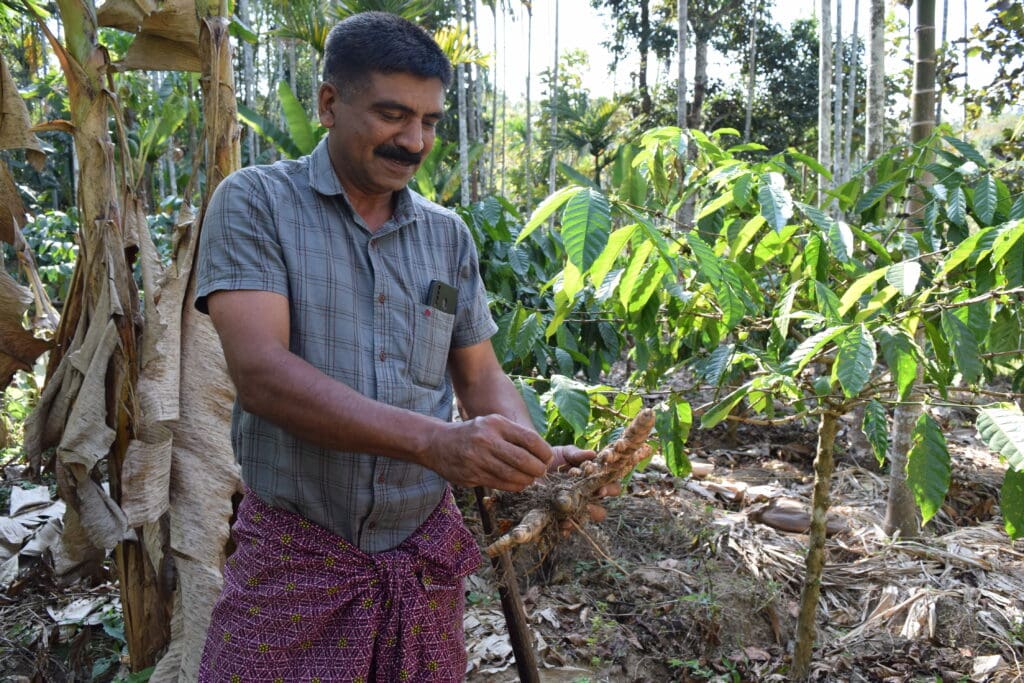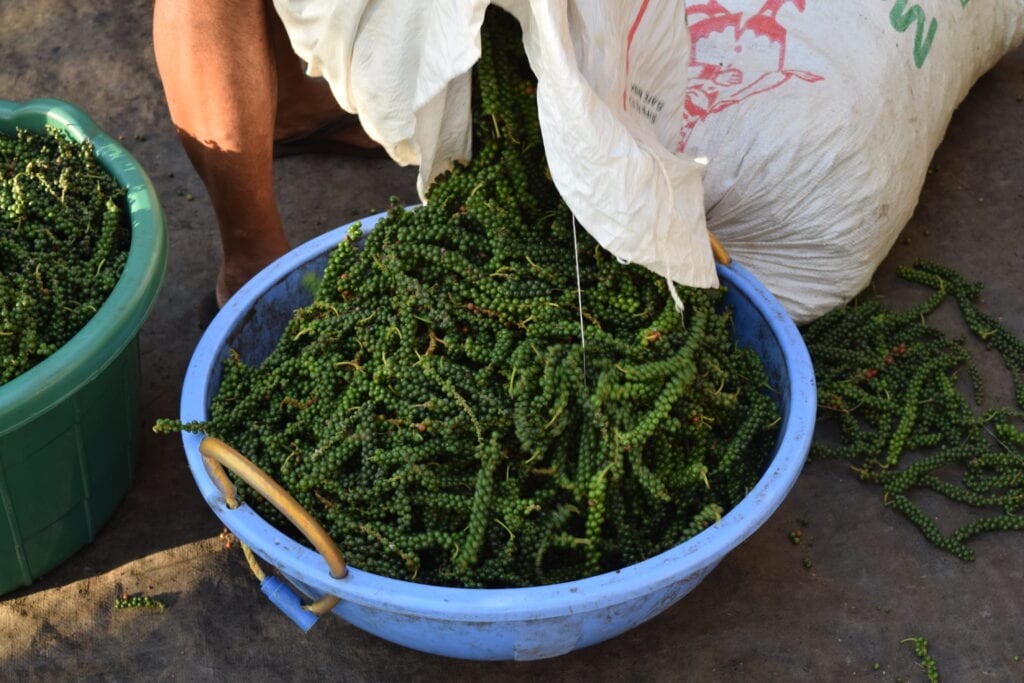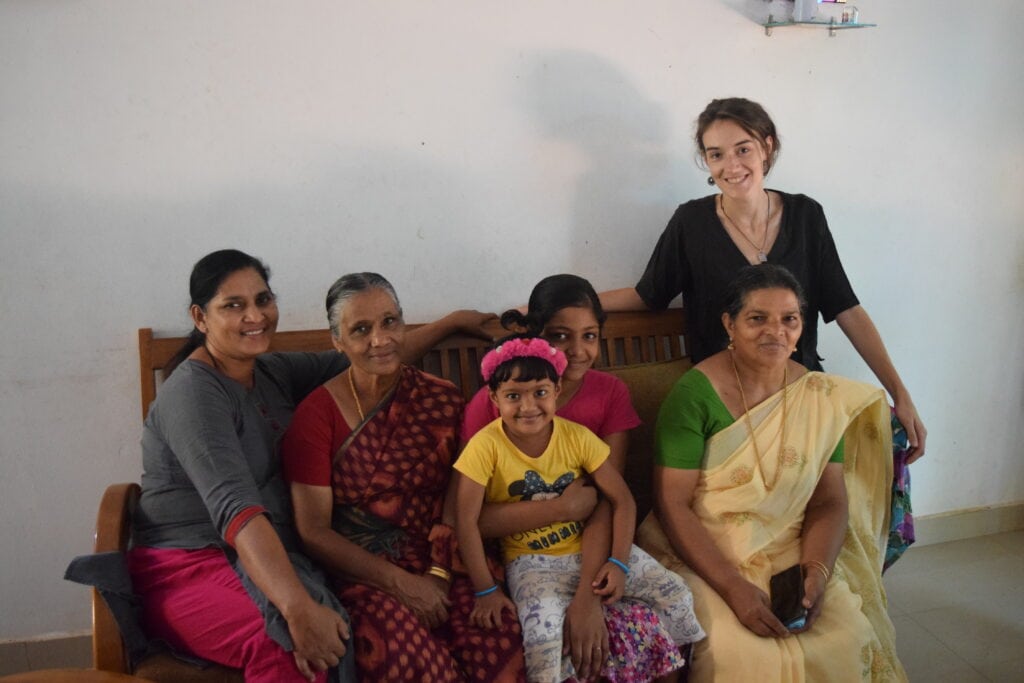Pepper production in Wayanad

India is the land of spices, as Crowd Container's range from Kerala makes clear. But how do all these roots, globules, powders and miraculous cooking ingredients grow? A question we also asked ourselves and were able to find out thanks to the help of Crowd Container. We visited a farm in Wayanad, Kerala, in February during our trip through southern India and found out where the Pepper grows.
When we got off the bus in Pulpally, a small town in the Wayanad area in the West Ghats mountains of Kerala, we still didn't know where and how long our stay would be. Traveling in South India seems to work best without planning every detail in advance, something we had almost become accustomed to. And thanks to wild elephants on the roadside of the last bus route, we were reminded that the best things happen unplanned anyway.
The hospitality with which we were received was no less impressive. Shinoj, head of the Wayanad department of FTAK (Fair Trade Alliance Kerala), took us by car from the village to the nearby farms and told us about the organization. The cooperative is divided into four districts: Kasargod, Kannur, Kozhikode and Wayanad. The first two mainly grow coconut and cashew, the latter mainly spices. In total, there are around 4,500 members in the alliance, 1,500 of them in Wayanad. All products are collected by FTAK in Kozhikode and then packaged and distributed by the company Elements.
Beena & Saju's diverse forest (garden)
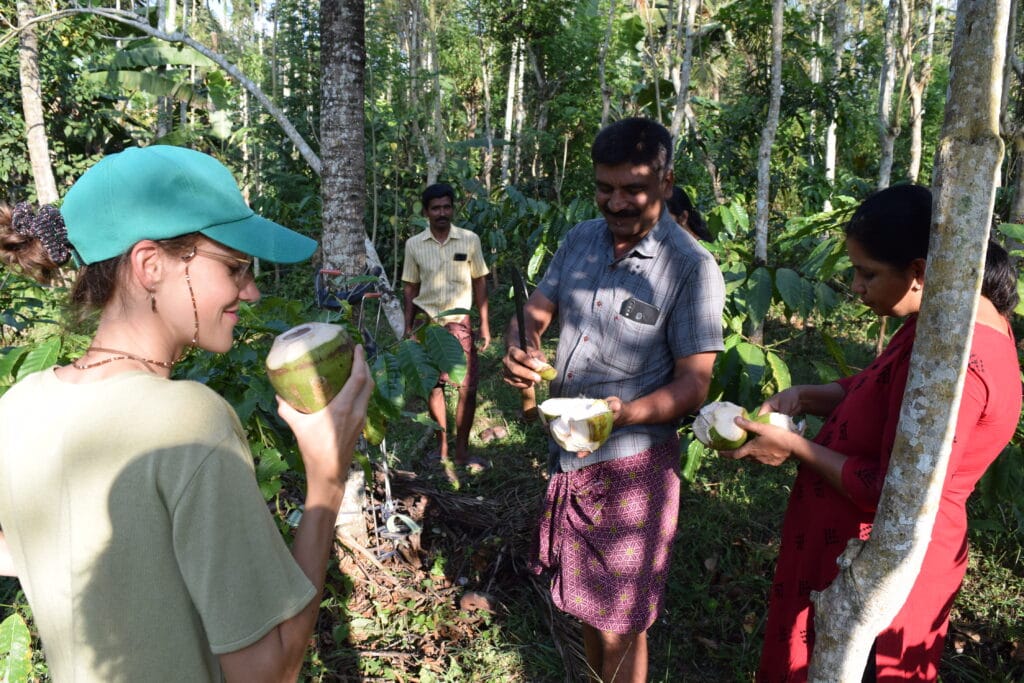
We were allowed to stay on the farm of Beena and Saju, who made their now vacant children's room available to us. Saju and Beena's English was basic, our Malayalam was zero. We often lacked words, but not the will and enthusiasm, so we always found a way to communicate. There was a warm welcome for us two strangers and, despite the late hour, a delicious dinner. From then on, we would never be short of food again; serving a variety of curries three times a day was an essential part of Beena and Saju's hospitality. Wonderful for people like us who love food.
The next morning, there was great curiosity about the area of just over one hectare below the house. The forest garden. A green wonderland stretched across six terraced fields, from which birdsong and scents beckoned. Saju proudly and with his heart-warming smile revealed to us the different plant species to be discovered in the garden. On entering, the term forest may seem more appropriate than garden; hard to imagine for the Swiss understanding of the term garden, but every single plant has its purpose and place. Up to 20 meters above the ground, silver oak, betel nut palms, rubber and tamarind trees are loosely distributed to provide some shade and prevent the almost vertical sun from drying out. In addition, the silver oak keeps water in the soil and, together with the other "auxiliary trees", supports the pepper plants, which climb up to 10 meters and produce peppercorns from the age of three. At the same height as the Pepper are various banana and coffee trees, which also enchanted us with their flowers. Some of the terraces below have yellow and white turmeric in the soil. On a level below the forest gardens, the farms share a rice field, which looked to us like a large clearing in the middle of the forest.
During the dry season, Saju has to water the forest garden once a week, occasionally adding some compost to the new plants, otherwise the garden manages almost on its own. The planting is clearly organized so that the various trees, shrubs etc. complement and support each other, making chemical treatments superfluous. The fact that there is no cocoa because the fruit has been damaged by mice and birds is nothing out of the ordinary. However, because the producers cultivate a variety of crops instead of relying on just one crop, this does not matter. Around Saju and Beena's house and forest garden, various crops are also grown for their own use: coconut palms, jackfruit, curry leaf, papaya and Nutmeg-trees and Cardamom. And the handful of goats provide fresh milk for the coffee. Everything was carefully explained to us by Saju, where possible we were shown how it is harvested and we were allowed to look, touch, smell and taste.
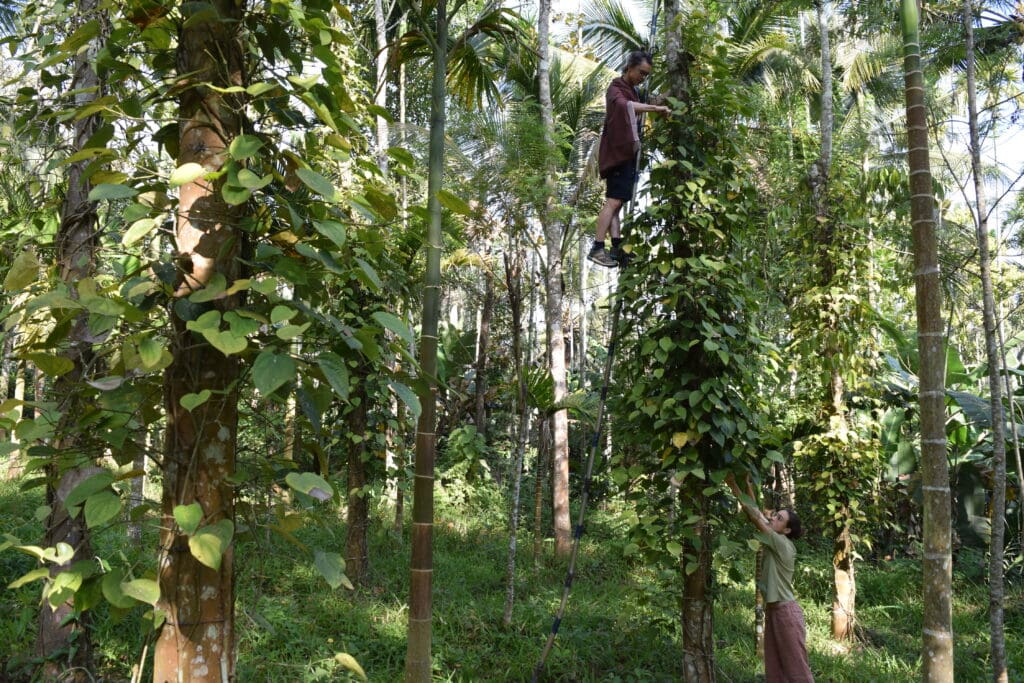
Harvesting & drying pepper
Full of zest for action, we were able to take part in the pepper harvest for a day together with the long-time harvester (even if it seemed a bit against hospitality) and were examined, commented on and photographed with amused smiles from various sides. The tools used for harvesting are a cloth for tying and collecting the green peppercorns and a single stile ladder (half ladder), which we first had to get used to. In the evening, we accompanied Saju as he took the harvest directly to the machine that FTAK had bought especially for this purpose to remove the stems. Tuktuks and cars brought enormous sacks full of pepper, a team that seemed to be well-rehearsed weighed the harvest of the respective producers, fed it into the machine and each grain was filled back into the sacks and the stems composted. A hustle and bustle that also provided an opportunity to exchange ideas.
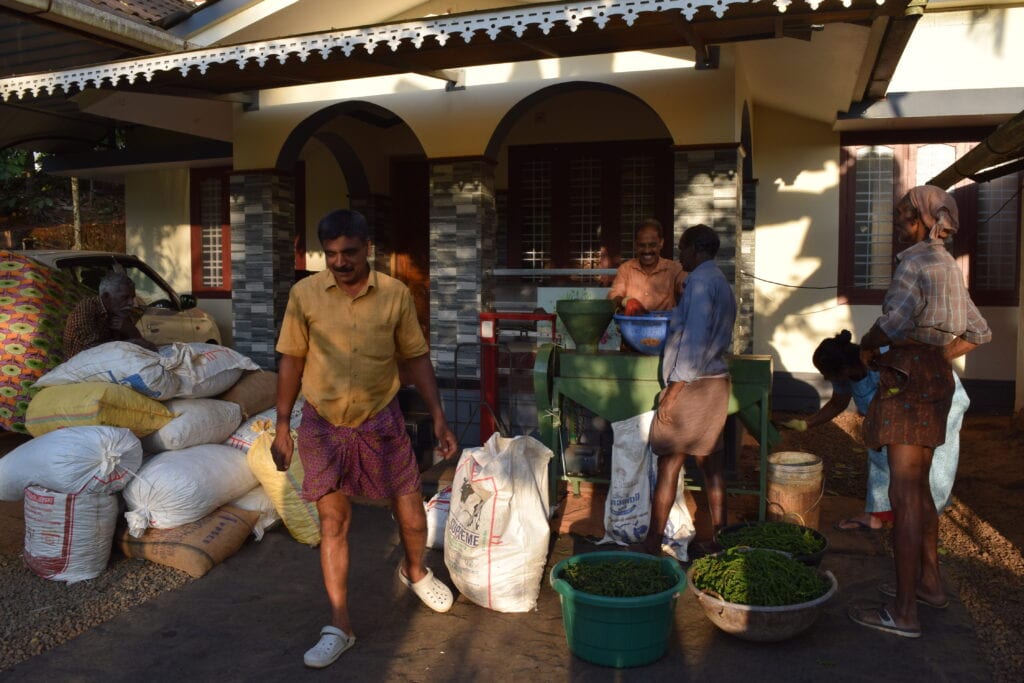
The next day, Saju made a small fire behind the house early in the morning to briefly put the peppercorns in boiling water before drying, so that the beautiful black color of the grains was guaranteed and the drying process in the sun could be reduced from five to two days. However, Saju and Shinoj explained to us when they once again answered our eternal questions. Normally, the grains would be placed directly on a flat roof or terrace to dry and turned regularly. After cleaning off small plant residues, the product is then ready for dispatch.
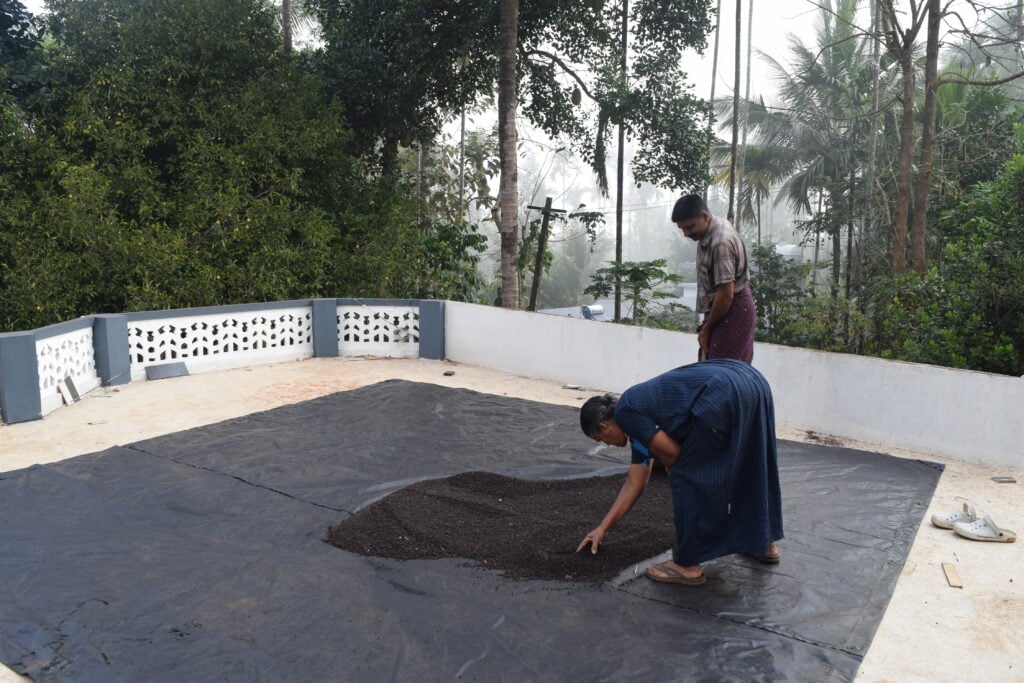
It's hard to believe how little we knew about pepper production, yet this spice has become an indispensable ingredient in every Swiss meal. Accordingly, we felt grateful to be able to look into this careful and sustainable process of one of the most frequently used spices. Our curiosity also drew us into the kitchen, where Beena prepared all kinds of delicious curries. Or perhaps it was the wonderfully spicy aroma that drew us in. We learned about the processing of coconut into oil and shredded coconut, the importance of curry leaves, the pungent smell of chili, the many spices and when and where they belonged, as well as various rice dishes.
Unknown fruits and wild elephants
Whenever we had some time between meals or forest garden visits, we were invited to visit relatives and neighbors who showed us around their gardens or houses and answered more questions about local plants. For example, the ones drying in front of the house CarnationsCinnamon trees, whose branches are cut to make the inner bark into the familiar Cinnamon powder fruit plantations with countless fruits that we had never heard of before or climbing aids that we used to scramble up coconut palms. After the tour, there was always the obligatory tea or coffee with questions about where we come from, what we do and how we like India. Each meeting was full of warmth, friendliness and interest. A hospitality that we took back to Switzerland as a model.
Until the fifth day, it remained unclear how long we would stay. We were in no hurry to leave and fortunately Beena and Saju were in no hurry to get rid of us either. But when we got up the courage to decide on a departure day, this plan was made impossible by a large demonstration in the village. Within a week, there had already been the second attack by wild elephants on farms in the area, in which two people had died. Although confrontations with elephants and tigers are part of everyday life, they seemed to have reached a level that was no longer acceptable for the inhabitants of the area. This second, large demonstration was aimed at the local politician, from whom they demanded more support instead of relying on wildlife. We were unable to ascertain exactly what interests this politician represented, why the elephants had attacked in the first place or what should be done about it, but there is no simple solution.
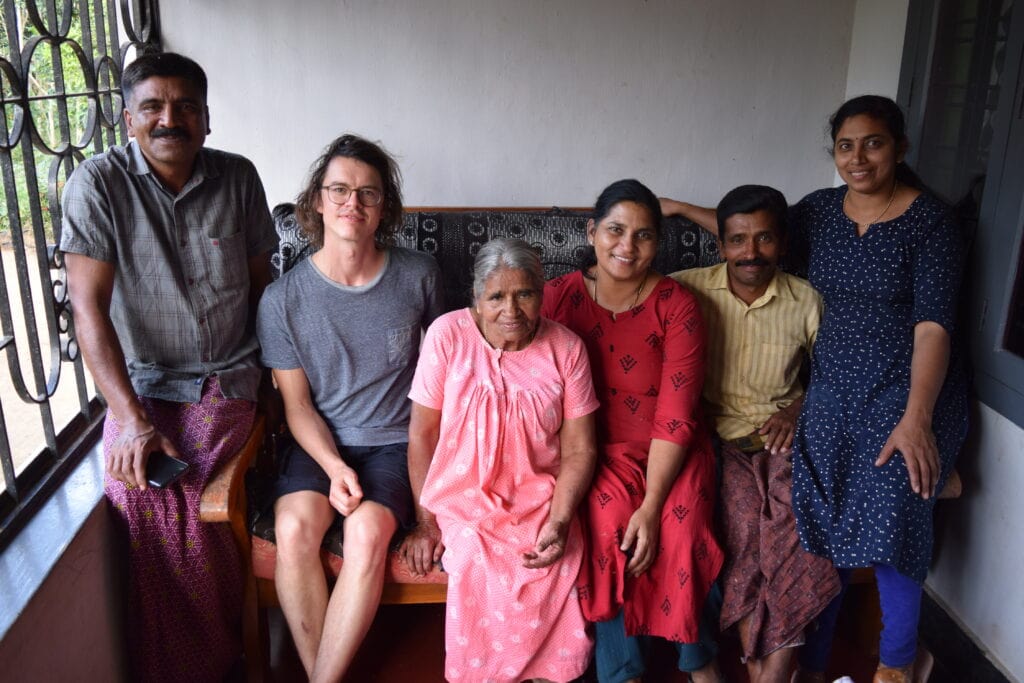
Our departure was therefore postponed until the next day after the church service. Shinoj's mother attended the earlier sermon with her youngest granddaughter so that she could prepare a delicious breakfast for us. Like so many things, the arrangements for this were made in advance, we were then informed about the individual circumstances of the day and were simply allowed to go with the flow. When we said goodbye, we learned something new and this time more about ourselves. When we brought our Swiss chocolate to each of the two families as a traditional souvenir, the recipients both turned the chocolate over in their hands and asked: "Is this fair trade?" And we were a little embarrassed to answer each time: No, because the choice was based on the typical Swiss brand and unfortunately it's not fair trade. Now, for the next time, we know what we want to prioritize.

Because we were able to enjoy Beena's wonderful curries in particular, we would like to share two recipes with you. You can find the recipes here.
